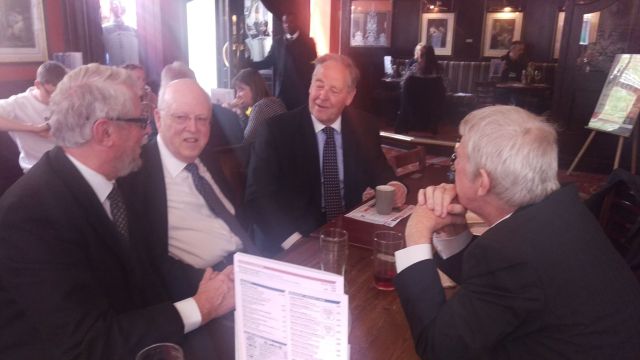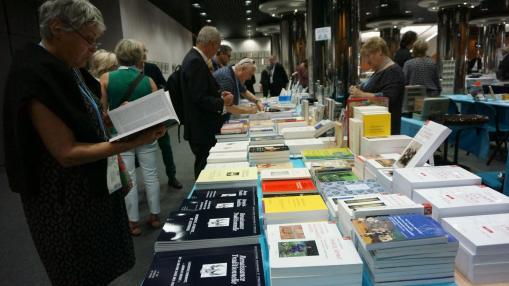 By Karen Kidd, PM
By Karen Kidd, PM
(I speak only for me)
I don’t know even half of you, but none of you will ever be so cool as the above photo.
On the far left is John Wade, classical linguist and noted historian, Masonic and otherwise, past master of the Quatuor Coronati Lodge No. 2076 and, since 2009, editors of QC’s Transactions (the AQC) since 2009. He also is a Prestonian Lecturer and can belt out “The Apprentice Song” like no one else.
To his left is S. Brent Morris, retired government cryptologic mathematician and soon-to-retire managing editor of The Scottish Rite Journal, published by the Supreme Council of the Scottish Rite Southern Jurisdiction. He has written extensively about Freemasonry, with not the least of his work being the “Complete Idiot’s Guide to Freemasonry.”
To Morris’ left is Mike Kearsley, editor of the Square, a UK-based independent magazine for Freemasons. Kearsley is a Prestonian lecturer and a recipient of Quatuor Coronati Lodge’s Norman Spencer Prize. He currently serves as the research lodge’s Secretary and is this year’s touring Kellerman lecturer.
Across the table is David Slater, past preceptor of Canberra Lodge of Research & Instruction, now Linford Lodge of Research where he is currently is Treasurer, Senior Warden at Discovery Lodge of Research, was the 2004 Kellerman lecturer and 2018 Norman B. Spencer Prize essayist.
The photo was taken at the Shakespeare’s Head in London this past spring by Neil Wynes Morse, one of the world’s leading experts in Masonic ritual development and past president of the Australia and New Zealand Masonic Research Council (ANZMRC).
These five, only a handful of the world’s researchers of Freemasonry, were in London for conferences on both sides of the English Channel and they took the opportunity for a meal, drinks and lots and lots of catching up. That is, in my opinion, the one primary value of Masonic research conferences: to remind researchers into the history and ritual of Freemasonry that they are not alone; not really.
Of course, most researchers, especially those in academia, will say that research conferences also are valuable because, among other things, they provide opportunities to present papers, receive critiques and find out what other researchers in the field are working on. All that is true but I haven’t met a Masonic researcher yet who didn’t feel they worked entirely too much on their own and those other benefits really boil down to the one primary value.
As a Masonic researcher, I know what it is to feel isolated in my work. The vast majority of Masonic researchers labor away to discover and preserve the history of the Craft and its ritual, all the while feeling overwhelmingly outnumbered by those who write about philosophy of the Craft and its esoterica. That crowd has a certain disregard for accuracy in history that I work very hard to be OK with but, quite frankly, it often causes issues for me when I’m trying to be taken seriously by historians and other researchers who are not Freemasons.
I’ve had to explain, entirely too often, that folks like Robert Lomas and Christopher Knight are not part of the much smaller herd with which I run and to beg acceptance as a more serious researcher with greater appreciation for the truth. Trust me, I have that.
That said, Masonic scholars of history and ritual have an equally well-earned reputation of running fast and loose with the truth that we also are still living down. In a not-so-very-long-ago time, myth and legend were preferred to cold, verifiable facts. Some wicked – and largely fabricated – stuff was churned out in the 19th and well into the 20th centuries and passed off as history. Sometimes, even today, those fairy tales still are quoted as truth.
It is little wonder that Freemasonry, until the last few decades, too often was what well-noted British Historian Frances Yates called “the happy-hunting ground of wildly imaginative and uncritical writers.”1 Yates added her voice to calls for a far, far, faaaaar more scientific approach to research into the history and Ritual of Freemasonry and she quoted a couple of Masonic researchers who are little known today but were giants in the field, in their time and now.
“It is time they should be investigated with proper historical and critical methods and there are signs that that time is approaching. In the preface to a book on the genesis of Freemasonry it is stated that the history of masonry ought not to be regarded as something apart but as a branch of social history, a study of a particular institution and the ideas underlying it ‘to be investigated and written in exactly the same way as the history of other institutions’.”
The preface to which Yates referred was in Douglas Knoop and G.P. Jones‘ seminal work in Masonic History, “The Genesis of Freemasonry,” published by Manchester University Press in 1947. The works by Knoop and Jones and other scholars like them remain required reading by those actually interested – and my observation is that most rank and file brothers aren’t at all interested – in genuine research into Freemasonry history and Ritual.
Knoop, Jones and others like them aren’t well known outside of research circles but they helped establish serious, science-based research into Freemasonry as a norm. They also firmly established Masonic research as a solitary and isolated labor, as I find it to be today.
Which confirms, in my opinion, the one primary value in Masonic conferences about history and scholarship – a chance for scholars who often work in isolation to meet up, network and remind each other that they are not really alone.
One better known conference is the prestigious World Conference on Fraternalism, Social Capital and Civil Society, aka the “WCF,” in France in odd numbered years and Washington in even numbered years. The conference is sponsored by the American Public University System, American Military University, American Public University, Phi Sigma Omega International, Westphalia Press, Musée de la Franc-Maçonnerie in Paris, and the University of Houston.

WCF chairs are Hoover Institution visiting fellow and George Mason University History Professor Paul Rich, French historian and Grand Orient de France Library Director Pierre Mollier and University of Houston Associate Professor Guillermo de los Reyes.
This year’s WCF featured 40 lectures and 20 panels from the world’s best Masonic scholars. The topic of next year’s conference, scheduled June 5 at the Historic Quaker Meetinghouse, is expected to be “Fraternal Art and Music,” while the 2121 WCF, scheduled May 27-29 that year at the The Bibliothèque Nationale in Paris, is expected to be about “Are the Ancient Landmarks Ancient?”
While the WCF certainly isn’t the only Masonic research conference (there also is the ICOM, also in France, which operates under the auspices of Louis Trabuchet), it is one of the best in that it offers presenters not only networking and gathering opportunities. The WCF also publishes papers presented during the conference, which in turn provides greater exposure for those papers beyond a room full of attendees.
Which often is about all the attention a Masonic scholar’s work will receive. The wider world seems little interested – unless aliens, conspiracy, world domination and other “sexy” stuff is written into the text. Rank-and-file Freemasons, who are strongly encouraged to “make a daily progress in masonry,” often treat research and history as little better than an amusing distraction.

So if scientific-based research into Masonic history and Ritual is a lonely labor with little reward beyond fleeting opportunities to meet up and network, why do Masonic researchers do this work?
That will be the topic of part II of this blog.
__________________________________
1. Page 294, “The Art of Memory” (Routledge and Kegan Paul, 1966).

